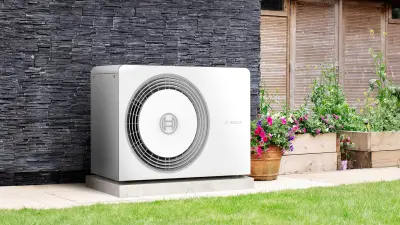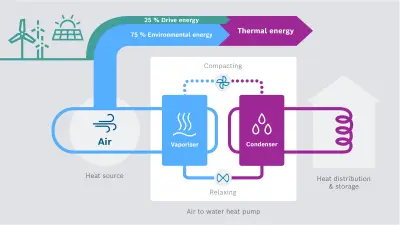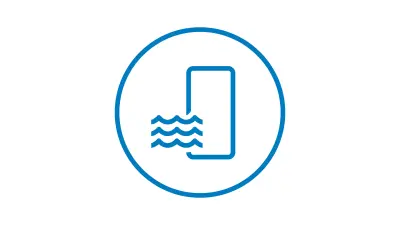How do heat pumps work? A beginner‘s guide
Smart heating technology from Bosch enables energy-efficient living

Setting the thermostat to the perfect temperature is vital when it comes to feeling comfortable at home and at work. But it is also one of the largest sources of CO₂ emissions, as the vast majority of heating systems installed in our cellars still run on oil and gas. This is what Bosch is on a mission to change with its most sustainable generation of heat pumps to date.
Heat pumps harness free ambient energy and require just a small amount of electricity to run, making these smart appliances an energy-efficient and environmentally friendly alternative to oil and gas heating systems.
Bosch offers a wide range of efficient heat pumps, tailored to whatever type of property you call home.
How heat pumps work
The technology powering Bosch’s heat pumps is based on the same principle as a refrigerator – but in reverse. While a refrigerator removes warm air from its interior to lower the temperature, a heat pump channels external energy into its interior. The source of this energy depends on the model of heat pump – it could be outside air, groundwater, or earth, for instance – but the key thing is that they are all freely available.
However, no matter which specific heat source it uses, every heat pump operates using the same four-stage process, which sees a liquid refrigerant evaporated, compressed, condensed, and expanded in a continuous cycle. This cycle makes it possible to raise the temperature of low-temperature heat to a level where it is usable. The heat pump only needs electricity to do this — and it is highly efficient. Let us take a closer look at the process:

- Energy absorption: The ambient air contained in the energy sources air, water, and earth is used to heat a refrigerant. The refrigerant absorbs the ambient air and gradually evaporates.
- Compression: The heated refrigerant is compressed by an electrically powered compressor, which heats up further, increasing the pressure.
- Release: When the desired temperature is reached, a heat exchanger transfers it to the heating water.
- Decompression: After the heat is released, the refrigerant is still under high pressure. The refrigerant is passed through an expansion valve and the process is repeated.
Comparing the different types of heat pump
There are three main types of heat pump: air-to-water, brine-to-water, and water-to-water. Air-to-water heat pumps are especially popular because they are easy to install, but they also require more electricity than the other types. The comparison below will provide you with an initial idea of which type of heat pump is best suited to which situation.
Air-to-water heat pumps

Air-to-water heat pumps from Bosch extract heat from the ambient air drawn into them. It uses one kilowatt-hour of electricity to produce many times that amount of thermal energy. In this way, new and renovated buildings can be fully heated all year round and hot water can be reliably provided without the need for an additional heating system.
An air-to-water heat pump can be installed both inside the building with a connection to the outside and outside the building directly on the building wall. In addition, it can not only provide heat, but also provide efficient cooling in the summer.
Air-to-water heat pumps are available either as a monobloc heat pump, where all the technical components are located within one unit, or as a split heat pump, where the process takes place in two separate units. Both systems work on the same principle, only the construction is different.
Brine-to-water heat pumps

Also known as geothermal heat pumps, brine-to-water heat pumps — to give them their correct name — use an environmentally harmless salt-water mixture (brine) as a heat transfer fluid, meaning they tap the earth as an energy source. This requires earth collectors or probes that are connected to the heat pump. The earth collectors are buried one to two meters deep in the ground and use the heat near the surface, while the probes reach up to 100 meters deep and tap into deep heat. A major advantage of brine-to-water heat pumps is that they can be used for cooling in the summer. In “reverse mode”, the system dissipates heat into the cool ground. The temperature gradient eliminates the need for compression. The result is efficient and economical air conditioning that regenerates the ground through heat dissipation.
Water-to-water heat pumps

A water-to-water heat pump — or groundwater heat pump — extracts thermal energy from groundwater by means of two wells. The temperature of the groundwater is largely constant throughout the year, so the heat pump provides high heating output in both summer and winter. This makes water-to-water heat pumps the most efficient heat pump heating systems. They are, however, somewhat more complicated to install. This is because these systems need two wells with a drilling depth of at least five meters and a distance between them of at least 15 meters — a suction well, which extracts the groundwater, and an absorption well, which releases the water used.
Many Bosch heat pumps can be combined with another heat generator, such as a gas condensing boiler, if required. These hybrid heat pumps are particularly suitable for existing buildings and are particularly efficient thanks to intelligent control that ensures the most appropriate heat generator is used at all times.



